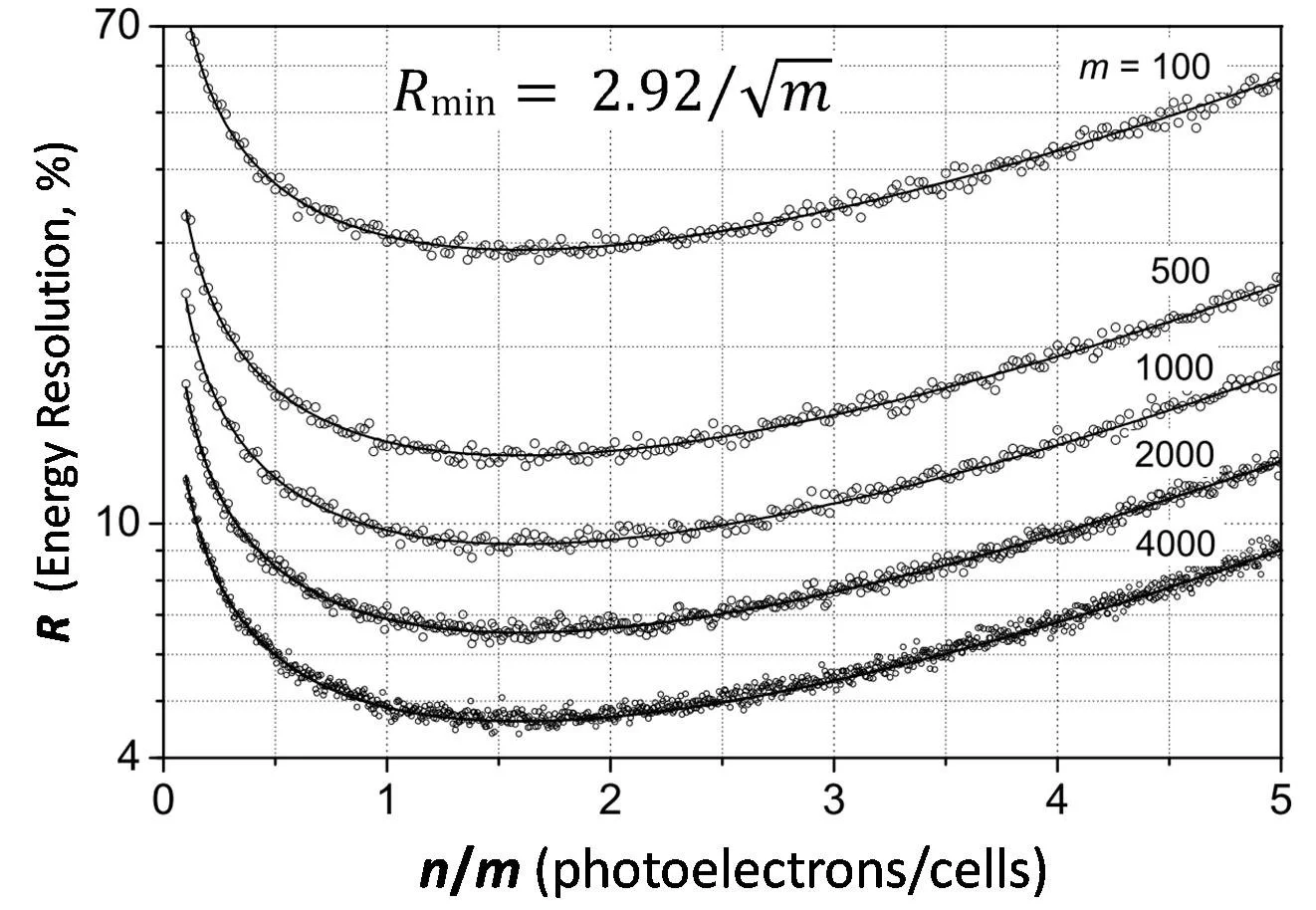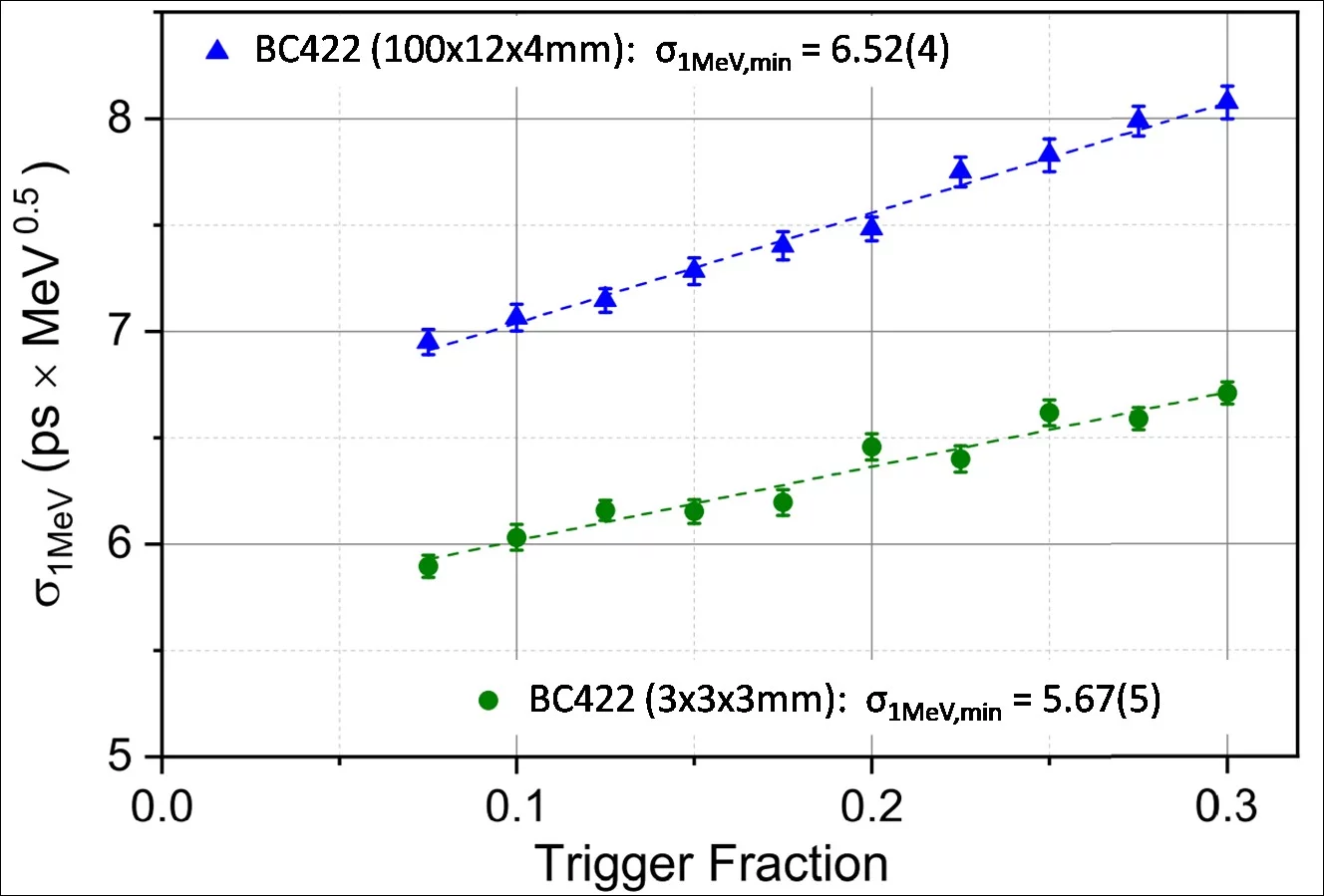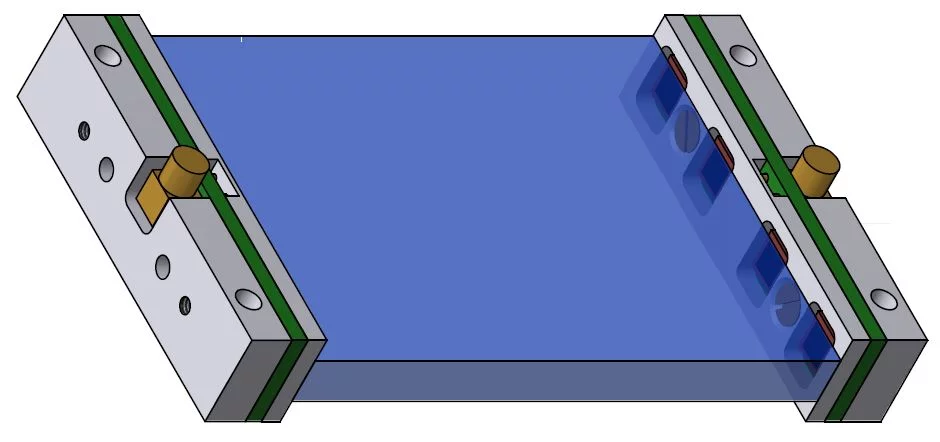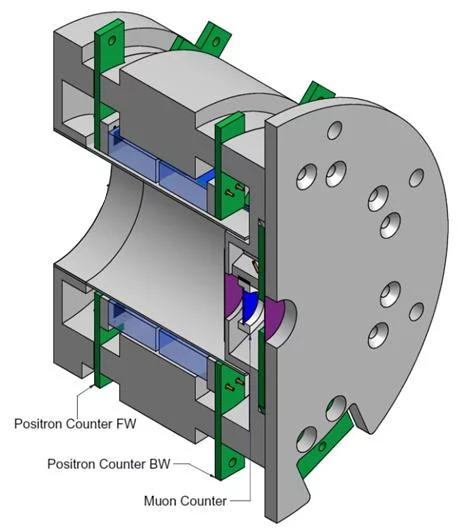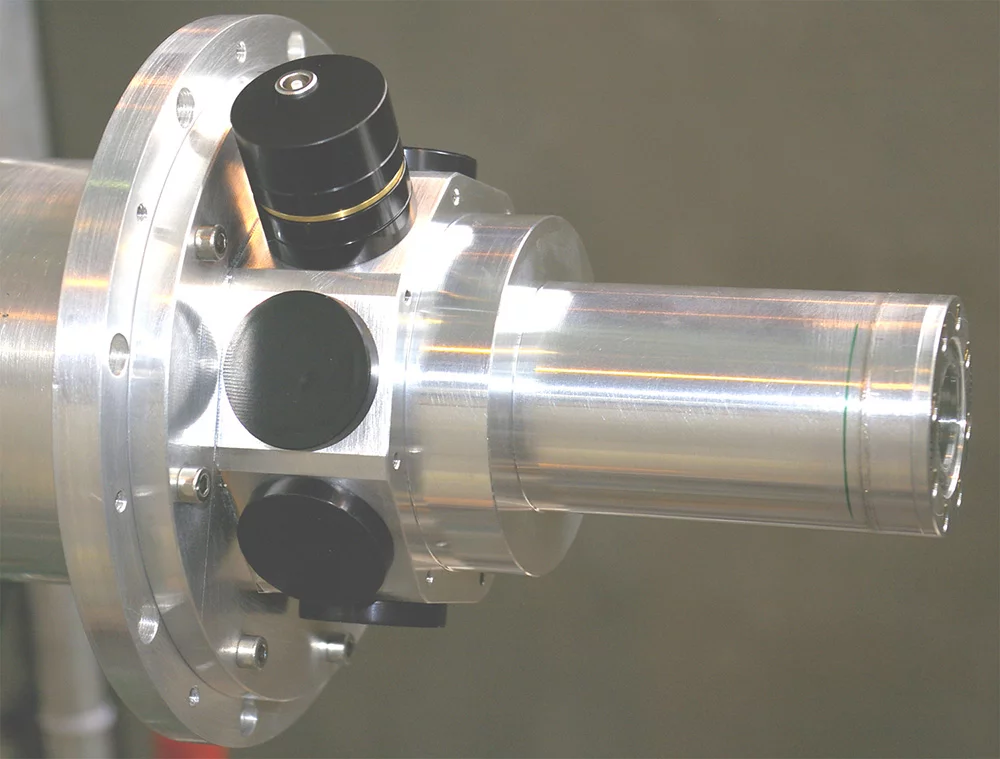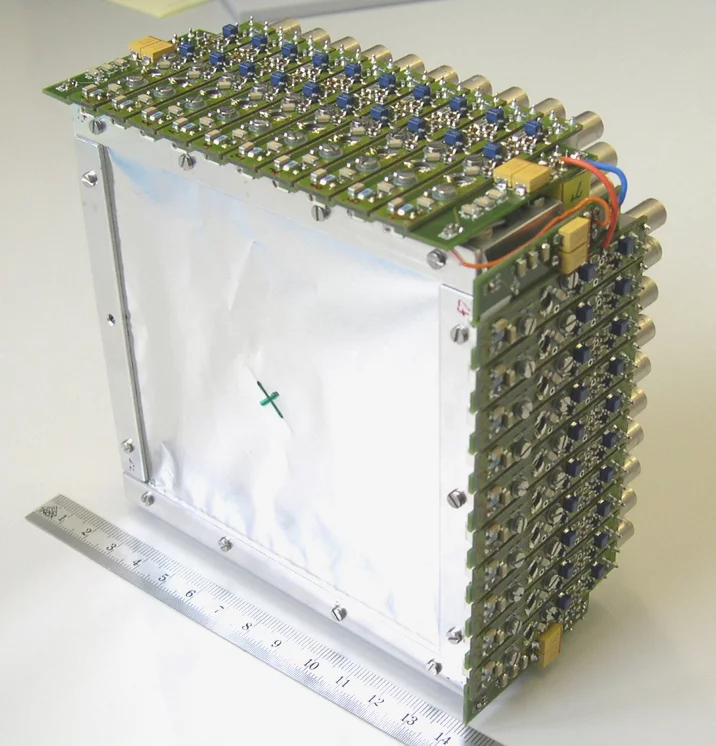Energy resolution limit of a SiPM based scintillation detector
The limited number of active pixels in a SiPM results not only in a non-linearity but also in an additional fluctuation of its response. Both these effects are taken into account to calculate the amplitude resolution of an ideal SiPM, which is shown to be finite. As one of the consequences, the energy resolution of a scintillation detector based on a SiPM is shown to be limited to some minimum value defined by the number of pixels in the SiPM.
A. Stoykov et al., “On the limited amplitude resolution of multipixel Geiger-mode APDs”, Journal of Instrumentation 2 (2007) P06005
Time resolution limit of a SiPM based scintillation detector
Plastic scintillators are widely used in particle detectors when precise timing information is required. As a basis for comparing different detectors we use such a characteristic as the time resolution per 1 MeV detected energy, i.e. the expected time resolution assuming the deposited energy in the scintillator equal to 1 MeV and all scintillation light is collected by the photosensor. The current best value of this parameter is about 6 ps, obtained with BC422 scintillator and Broadcom AFBR-S4N44C013 SiPM.
A. Stoykov and T.Rostomyan, “Time resolution of BC422 plastic scintillator read out by a SiPM”, http://arxiv.org/abs/2103.11391v1
K. Sedlak et al., “A GEANT4 study on the time resolution of a fast plastic scintillator read out by a G-APD”, Nucl. Instr. and Meth. A 696 (2012) 40
A. Stoykov et al., “A time resolution study with a plastic scintillator read out by a Geiger-mode Avalanche Photodiode”, Nucl. Instr. and Meth. A 695 (2012) 202
A SiPM based ZnS(Ag):6LiF scintillation neutron detector
Helium-3 has been for several decades the most widely used converting material in detectors for neutron scattering experiments. The world-wide shortage of its supply increased significance and stimulated further development of alternative detector technologies. One of these alternatives is the scintillation technology based on ZnS:6LiF scintillators read out by wavelength-shifting (WLS) fibers. Currently all detectors of this kind utilize photomultiplier tubes (PMTs) as photosensors.
The application of SiPMs in such detectors has been hindered by their orders of magnitude higher dark count rate at room temperature. We solve this problem by substantially improving the light collection from the scintillator and by using an efficient algorithm for separating the signals from the dark counts. The developed prototype detector shows performance parameters comparable or exceeding those of the current PMT based detectors.
A.Stoykov et al., “Evaluation of a ZnS:6LiF based scintillation neutron detector at high counting rates”, Nucl. Instr. and Meth. A 936 (2019) 34
M.Hildebrandt et al., “Evaluation of ZnS:6LiF and ZnO:6LiF Scintillation Neutron Detectors Readout With SiPMs”, IEEE Transactions on Nuclear Science 65(8) (2018) 2061
J.-B. Mosset et al., “A 16-ch module for thermal neutron detection using ZnS:6LiF scintillator with embedded WLS fibers coupled to SiPMs and its dedicated readout electronics”, Nucl. Instr. and Meth. A 845 (2017) 494
A.Stoykov et al., “Trigger Efficiency of a ZnS:6LiF Scintillation Neutron Detector Readout with a SiPM”, IEEE Transactions on Nuclear Science 63(4) (2016) 2271
J.-B. Mosset et al., “Digital signal processing for a thermal neutron detector using ZnS(Ag):6LiF scintillating layers read out with WLS fibers and SiPMs”, Nucl. Instr. and Meth. A 824 (2016) 319
M. Hildebrandt et al., “Detection of thermal neutrons using ZnS(Ag):6LiF neutron scintillator read out with WLS fibers and SiPMs”, Nucl. Instr. and Meth. A 824 (2016) 204
A. Stoykov et al., “A SiPM-based ZnS:6LiF scintillation neutron detector”, Nucl. Instr. and Meth. A 787 (2015) 361
J.-B. Mosset et al., “Evaluation of two thermal neutron detection units consisting of ZnS/6LiF scintillating layers with embedded WLS fibers read out with a SiPM”, Nucl. Instr. and Meth. A 764 (2014) 299
A. Stoykov et al., “Use of Silicon Photomultipliers in ZnS:6LiF scintillation neutron detectors: signal extraction in presence of high dark count rates”, Journal of Instrumentation 9 (2014) P06015
J.-B. Mosset et al., “Upgrade of the POLDI diffractometer with a ZnS(Ag)/6LiF scintillation detector read out with WLS fibers coupled to SiPMs”, Journal of Physics: Conference Series 528 (2014) 012041
Detector systems for the general-purpose μSR instruments
We developed and brought into operation detector systems for the general-purpose muon-spin rotation (μSR) experiments GPS, GPD, and FLAME at the Laboratory for Muon Spin Spectroscopy.
Existing bulky detector system of the GPS and GPD instruments, representing a set of scintillation detectors consisting of plastic scintillators, light guides, and PMTs, were replaced by a more compact and lightweight version in which the light guides are excluded and PMTs are replaced by SiPM arrays, resulting in improved timing performance and lower operation voltage. The same technology is utilized to build a detector system for the new FLAME instrument.
A. Amato et al., “The new versatile general purpose surface-muon instrument (GPS) based on silicon photomultipliers for µSR measurements on a continuous-wave beam”, Review of Scientific Instruments 88 (2017) 093301
High-time resolution detector for the 9.5 Tesla μSR instrument
Detector system for the HAL-9500 instrument was developed. The detector satisfies strict requirements on the time resolution and compactness. Muon-spin precession signals with frequencies up to 1.3 GHz in magnetic fields up to 9.5 T are easily detected, the reduction of the signal amplitude does not exceed 20 %. The accuracy in measuring the muon-positron time correlations is about 80 ps (sigma) – the time resolution unprecedented for such high fields. The small radial dimension of the detector ring allows detecting the decay positrons with the spiral radius down to 1 cm. To preserve the 10 ppm uniformity of the magnetic field at the sample position all detector components located in the vicinity of the sample are non-magnetic.
A. Stoykov et al., “High field muSR instrument at PSI: detector solutions”, Physics Procedia 30 (2012) 7
A lens-coupled scintillation counter in cryogenic environment
An elegant approach for integrating a scintillation counter into a cryogenic system is developed. Its distinguishing feature is the absence of a continuous light guide coupling the scintillation and the photodetector parts, operating at cryogenic and room temperatures respectively. The detector consists of a plastic scintillator with glued-in wavelength-shifting fiber located inside a cryostat, a SiPM outside the cryostat, and a lens system guiding the scintillation light re-emitted by the fiber to the SiPM through optical windows in the cryostat shields.
This approach is used to incorporate a set of scintillation counters serving as a Veto detector into a dilution refrigerator used by the HAL-9500 instrument. The scintillation part of the detector is operated at the temperature of 1 K. Any other solution would require modifications to the cryostat design with enormously increased cost of the system.
A. Stoykov et al., “A lens-coupled scintillation counter in cryogenic environment”, Journal of Instrumentation 6 (2011) P02003
A scintillating fiber detector for muon-beam profile measurements
A position sensitive scintillating fiber detector with readout of the fibers by SiPMs was developed and used for the measurement of the 29MeV/c muon beam profiles in magnetic fields up to 5 Tesla. Comparing the results with simulations helped us to understand the effect of high magnetic fields on the particle trajectories in the muon-spin rotation experiment. This was an important step towards development of the 9.5 Tesla μSR instrument at PSI. The discussed detector was one of the first developments worldwide where SiPMs found their application.
A. Stoykov et al., “A scintillating fiber detector for muon beam profile measurements in high magnetic fields”, Nucl. Instr. and Meth. A 550 (2005) 212
T. Lancaster et al., “Magnetic field effects on particle trajectories in the muon-spin relaxation experiment: Towards a high-field spectrometer”, Nucl. Instr. and Meth. A 580 (2007) 1578


